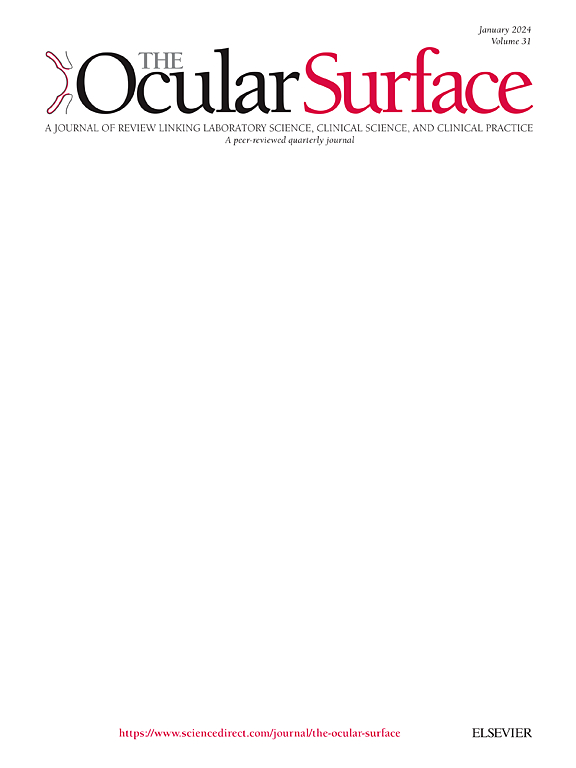Predictors of vision-related quality of life in patients treated for filamentous fungal keratitis
IF 5.6
1区 医学
Q1 OPHTHALMOLOGY
引用次数: 0
Abstract
Purpose
To identify clinical characteristics that predict vision-related quality of life (QoL) in patients with fungal keratitis three months after treatment.
Methods
Patients with fungal keratitis enrolled in the Cross-Linking Assisted Infection Reduction trial were treated with topical natamycin 5 % or amphotericin 0.15 %, with or without adjuvant corneal cross-linking (CXL). Demographic data, ulcer characteristics, clinical course, and responses to the Indian Visual Function Questionnaire (IND-VFQ) were collected at baseline and follow-up. Logistic regression models were used to assess factors associated with patient-reported vision-related QoL at three months. Analyses included the average IND-VFQ score as well as Rasch-derived subscale scores for vision-specific mobility, activity limitation, psychosocial impact, and visual symptoms.
Results
Of 111 participants enrolled, 86 had complete data at both timepoints. Multivariable models identified baseline IND-VFQ score, scar size, and presence of hypopyon as significant predictors of 3-month IND-VFQ scores. A 1-point change in best spectacle corrected visual acuity is correlated with a 13.4-point change in the opposite direction in average IND-VFQ (P=0.001). Patients with adverse events requiring surgery had lower 3-month IND-VFQ scores than those managed medically (P=0.001). Ulcer characteristics including location, depth, symptom duration, repeat culture positivity, organism type, and fungal genus were not associated with final IND-VFQ scores.
Conclusions
Vision-related QoL after fungal keratitis is significantly influenced by change in visual acuity, need for surgical intervention, and select baseline factors including scar size, initial IND-VFQ score, and presence of hypopyon. Vision-related QoL did not differ by antifungal treatment or adjuvant CXL use.
丝状真菌性角膜炎患者视力相关生活质量的预测因素。
目的:确定预测真菌性角膜炎患者治疗后3个月视力相关生活质量(QoL)的临床特征。方法:参加交联辅助减少感染试验的真菌性角膜炎患者接受5%纳他霉素或0.15%两性霉素外用治疗,伴或不伴角膜交联(CXL)。在基线和随访时收集人口统计数据、溃疡特征、临床病程和对印度视觉功能问卷(IND-VFQ)的反应。使用逻辑回归模型评估与患者报告的三个月视力相关生活质量相关的因素。分析包括IND-VFQ的平均得分以及rasch衍生的视觉特异性活动能力、活动限制、社会心理影响和视觉症状的亚量表得分。结果:在111名参与者中,86名在两个时间点都有完整的数据。多变量模型确定基线IND-VFQ评分、疤痕大小和假说的存在是3个月IND-VFQ评分的重要预测因素。最佳眼镜矫正视力变化1点与平均IND-VFQ相反方向变化13.4点相关(P=0.001)。需要手术的不良事件患者的3个月IND-VFQ评分低于药物治疗的患者(P=0.001)。溃疡特征包括位置、深度、症状持续时间、重复培养阳性、生物体类型和真菌属与最终IND-VFQ评分无关。结论:真菌性角膜炎术后的视力相关生活质量受视力变化、手术干预需要、疤痕大小、初始IND-VFQ评分、是否存在垂体后叶等基线因素的影响。抗真菌治疗或辅助使用CXL对视力相关的生活质量没有影响。
本文章由计算机程序翻译,如有差异,请以英文原文为准。
求助全文
约1分钟内获得全文
求助全文
来源期刊

Ocular Surface
医学-眼科学
CiteScore
11.60
自引率
14.10%
发文量
97
审稿时长
39 days
期刊介绍:
The Ocular Surface, a quarterly, a peer-reviewed journal, is an authoritative resource that integrates and interprets major findings in diverse fields related to the ocular surface, including ophthalmology, optometry, genetics, molecular biology, pharmacology, immunology, infectious disease, and epidemiology. Its critical review articles cover the most current knowledge on medical and surgical management of ocular surface pathology, new understandings of ocular surface physiology, the meaning of recent discoveries on how the ocular surface responds to injury and disease, and updates on drug and device development. The journal also publishes select original research reports and articles describing cutting-edge techniques and technology in the field.
Benefits to authors
We also provide many author benefits, such as free PDFs, a liberal copyright policy, special discounts on Elsevier publications and much more. Please click here for more information on our author services.
Please see our Guide for Authors for information on article submission. If you require any further information or help, please visit our Support Center
 求助内容:
求助内容: 应助结果提醒方式:
应助结果提醒方式:


